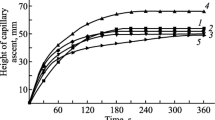Polymer composites are widely applied in various areas of human activity. The components constituting them, particularly those reinforcing the textiles, largely determine their properties. The present work posed the problem of determining the compatibility of polymer binders and reinforcing polypropylene fabric during technology development for producing composites based on them using parameters such as the surface tension, contact angle, work of adhesion, relative elongation, and strength of the binding and reinforcing materials.



Similar content being viewed by others
References
I. A. Prokhorova, M. Bkkar, et al., Izv. Vyssh. Uchebn. Zaved., Tekhnol. Legk. Prom-sti., 43, No. 1, 60-64 (2019).
M. L. Kerber, V. M. Vinogradov, et al., in: Polymer Composite Materials: Structure, Properties, Technology: Study Aide for Higher Education Institutions [in Russian], A. A. Berlin (ed.), Professiya, St. Petersburg, 2008, 560 pp.
V. V. Leonov, O. A. Artem’eva, and E. D. Kravtsova, Materials Science and Technology of Composite Materials: Study Guide for Higher Education Institutions [in Russian], Sibirskii Federal2nyi Univ., Krasnoyarsk, 2007, 241 pp.
L. I. Bondaletova and V. G. Bondaletov, Polymer Composite Materials, Part 1: Study Guide for Higher Education Institutions [in Russian], Tomskii Politekhnich. Univ., Tomsk, 2013, 118 pp.
Epoxide resin KEP 828; https://ru-smola.com/epoxy_lib.html/, (2018).
Instructions for KEP 828 resin, NGK Composite Materials, StP, 2003-2019; https://igc-market.ru/shop/smolyepoksidnye_smoly/ker828_smola_epoksidnaya_5_kg/; (2018).
Technical Information for SKU-PFL-100; http://www.surel.ru/polyurethanes/forpolymers/1/sku-pfl-100/; (2018).
R. M. Dolinskaya, N. R. Prokopchuk, and M. E. Leizeronok, Chemistry and Technology of Organic Substances, Materials and Items [in Russian], BGTU, Belarus, 2015, No. 4, pp. 37-41.
V. D. Al’perna and G. A. Gladkovskogo, Composite Materials Based on Polyurethanes [in Russian], Khimiya, Moscow, 1982, 240 pp. [translated from English, F. A. Shutov (ed.)].
Technical Information for MOCA, Scientific-Production Enterprise, St. Petersburg; http://www.surel.ru/polyurethanes/auxiliary/86/25/, (2018).
N. I. Baurova and V. A. Zorii, Use of Polymer Composite Materials in the Manufacturing and Repair of Machines: Study Aide for Higher Education Institutes [in Russian], MADI, Moscow, 2016, 264 pp.
V. E. Galygin, G. S. Baronin, et al., Modern Technologies for Producing and Processing Polymer and Composite Materials [in Russian], TGTU, Tambov, 2012, 180 pp.
R. M. Jones, Mechanics of Composite Material, 2nd Ed., Virginia Polytechnic Institute and State University, 1999.
B. Harris, Engineering Composite Materials, Institute of Materials, London, 1999.
K. E. Perepelkin, Reinforcing Fibers and Fibrous Polymer Composites [in Russian], Nauchnye Osnovy i Tekhnologii, St. Petersburg, 2009, 380 pp.
K. O. Strokin, Prediction of Strength Properties of Composite Materials Reinforced by Carbon Fabrics [in Russian], Candidate Dissertation, SPbGUPTD, St. Petersburg, 2018, 182 pp.
Y. A. Cengel and J. M. Cimbala, Fluid Mechanics: Fundamentals and Applications, McGraw-Hill Series in Mechanical Engineering, 2006.
C. K. Batchelor, An Introduction to Fluid Dynamics, University of Cambridge, 2000.
C. P. Henry, US Pat. Appl. 20140205793 A1, Int. Cl. B32B5/12, B64C1/12, D06M17/00, D06M15/55, D06M15/643, Jul. 24, 2014, “Multiple-resin composite structures and methods of producing the same.”
M. Azeem, A. Boughattas, et al., Fibres Text., No.4, 58-65 (2017).
Author information
Authors and Affiliations
Corresponding author
Additional information
Translated from Khimicheskie Volokna, No. 2, pp. 60-65, March—April, 2022.
Rights and permissions
Springer Nature or its licensor (e.g. a society or other partner) holds exclusive rights to this article under a publishing agreement with the author(s) or other rightsholder(s); author self-archiving of the accepted manuscript version of this article is solely governed by the terms of such publishing agreement and applicable law.
About this article
Cite this article
Prokhorova, I.A., Bkkar, M. Justification for the Choice of Polymer Binder for Composites Based on Reinforced Polypropylene Yarns. Fibre Chem 54, 115–120 (2022). https://doi.org/10.1007/s10692-022-10356-9
Published:
Issue Date:
DOI: https://doi.org/10.1007/s10692-022-10356-9



